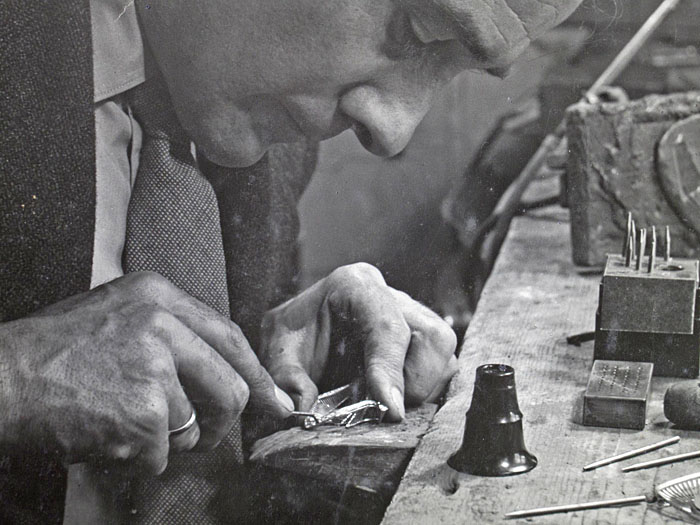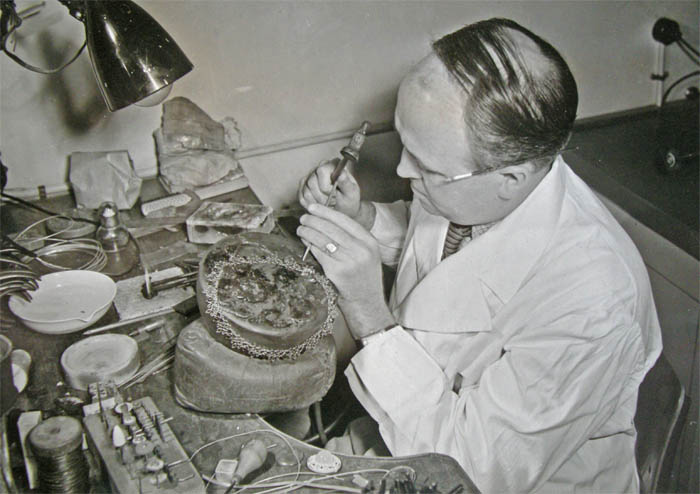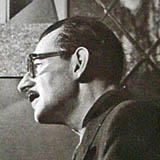|
The Martinshof Story - Page 5
Page |
Previous |
Next ||
1 |
2 |
3 |
4 |
5 |
6 |
7 |
8 |
9 |
10 |
11 |
12 |
13 |
14 |
15 |
16 |
? |
Next -
Previous -
Top -
Page 1 -
Photos -
Michael's Blog -
Jazclass Links
17. Atelier Martinshof : Archibald Dumbar and Chris Steenbergen
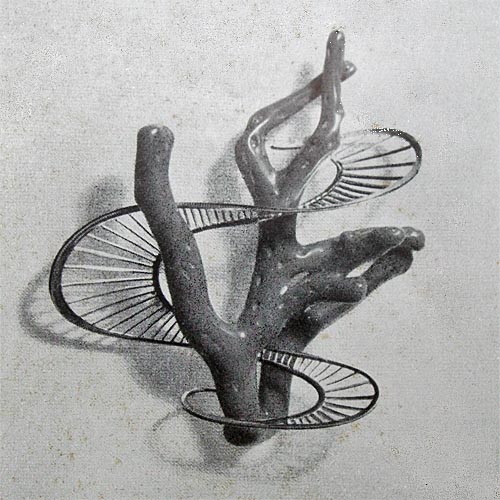 Annie Martinus stayed with us at Martinshof until after our return from Germany and
left in 1947 together with the other temporary house guests. She was (I believe) never
employed by Atelier Martinshof but held continuous contact with my parents.
Annie Martinus stayed with us at Martinshof until after our return from Germany and
left in 1947 together with the other temporary house guests. She was (I believe) never
employed by Atelier Martinshof but held continuous contact with my parents.
Annie soon
married the Amsterdam goldsmith Archibald Dumbar, while her sister Jannie
Martinus married the goldsmith Chris Steenbergen at around the same time.
It
was through Annie (now Annie Dumbar) that my father was introduced to these two
young and upcoming modern artists. Both worked in their own studios in Amsterdam, but
right from the early 1950s contributed to the Martinshof Collection during exhibitions
throughout the Atelier Martinshof years. My father would also take their work around the
country while visiting jewelry shops throughout Holland.
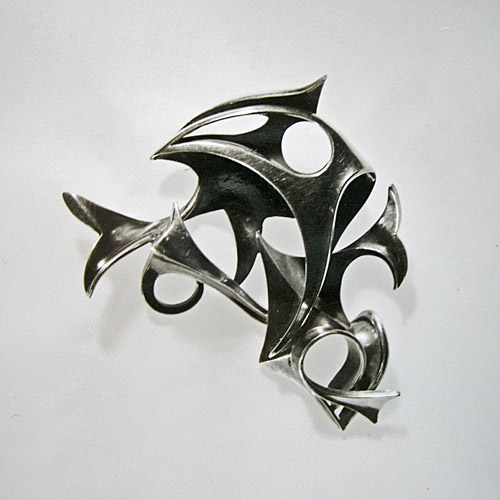 Both goldsmiths won the prestigious European Goldsmith of the Year Award (each probably
several times).
Both goldsmiths won the prestigious European Goldsmith of the Year Award (each probably
several times).
Although these two brilliant artists have long since died, there still remains an intimate
relationship between them and the Furstner family. Chris Steenbergen designed and
made my signet ring (with
family crest) in 1958 for my 21st birthday and Archibald Dumbar made one for my
daughter Babette in 1983.
As mentioned above, Annie never officially worked at Martinshof but her youngest
daughter Gwendoline Dumbar
did for a while during the 1970s, which I believe she much enjoyed. Roel Fischer
too, married to Annie's oldest daughter Astre, worked at Martinshof for a few years
during that period.
Book : "Chris Steenbergen"
Published in 2000 by Stichting Fonds voor Beeldende Kunsten, Vormgeving en Bouwkunst,
Postbus 773, 1000 AT Amsterdam, The Netherlands.
The original Atelier Martinshof team
Next -
Previous -
Top -
Page 1 -
Photos -
Michael's Blog -
Jazclass
18. Atelier Martinshof : Magazine 'Eloy'
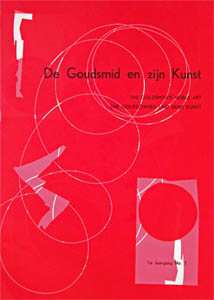 One of the objectives of Atelier Martinshof was to elevate the goldsmith to the same
recognition and artistic level as other artists like painters, sculptors, composers etc.
As part of this purpose my father published a specific goldsmiths magazine The Goudsmit
en zijn
Kunst ("The Goldsmith's Noble Art"). The name was later changed to
Eloy after
the Patron Saint of the goldsmiths' guild "St. Eiligius".
One of the objectives of Atelier Martinshof was to elevate the goldsmith to the same
recognition and artistic level as other artists like painters, sculptors, composers etc.
As part of this purpose my father published a specific goldsmiths magazine The Goudsmit
en zijn
Kunst ("The Goldsmith's Noble Art"). The name was later changed to
Eloy after
the Patron Saint of the goldsmiths' guild "St. Eiligius".
The text of the magazine
was printed in four languages, Dutch, German, English and French and it presented work of
artists from Holland, Germany, Sweden, Switzerland, Italy, France, Scandinavia and even
the USA (Adda Husted-Anderson from New
York).
Cor van Weele
from Amsterdam, the principal photographer for the Martinshof Collection, designed the
attractive modern front covers for it.
Unfortunately, probably because of financial
restraints, only two editions of the magazine (in the early 1950s) were ever published.
 My father's promotional efforts with the Magazine Eloy can be seen as part of a European
wide push at that time to give goldsmiths wider and greater recognition. The
culmination of this effort was
the yearly selection of a European Goldsmith of the Year instigated by the
German Gesellschaft für Goldschmiedekunst ("German Guild of Goldsmiths") after
WW2. The recipient of this award received a Ring of Honour
traditionally designed and crafted by the previous year's winner. A wonderful idea. It was
internationally recognised as the highest ranking Goldsmith award in the world.
My father's promotional efforts with the Magazine Eloy can be seen as part of a European
wide push at that time to give goldsmiths wider and greater recognition. The
culmination of this effort was
the yearly selection of a European Goldsmith of the Year instigated by the
German Gesellschaft für Goldschmiedekunst ("German Guild of Goldsmiths") after
WW2. The recipient of this award received a Ring of Honour
traditionally designed and crafted by the previous year's winner. A wonderful idea. It was
internationally recognised as the highest ranking Goldsmith award in the world.
Next -
Previous -
Top -
Page 1 -
Photos -
Michael's Blog -
Jazclass Links
19. Atelier Martinshof : Edda Marie Dierkes and Sigurd Persson
 Besides the core group of Dutch artists (Maud Smit, Eweg, Chris Steenbergen, Archibald
Dumbar, plus the young addition Dea
Mulder) several artists from outside the Netherlands also contributed with their work
to the Martinshof Collection.
Besides the core group of Dutch artists (Maud Smit, Eweg, Chris Steenbergen, Archibald
Dumbar, plus the young addition Dea
Mulder) several artists from outside the Netherlands also contributed with their work
to the Martinshof Collection.
One was Edda Marie Dierkes Prinzessin zu Erbach Schönberg (a
cousin of the then Dutch Queen Juliana) from Darmstadt in Germany. As a young student I
visited her once with my father at her home in Darmstadt, a very beautiful and intelligent
woman. She contributed regularly to the Martinshof Expositions with some bold very
attractive work.
Other German contributors included Elisabeth Treskow from
Köln and Otto Hahn from
Bielefeld.
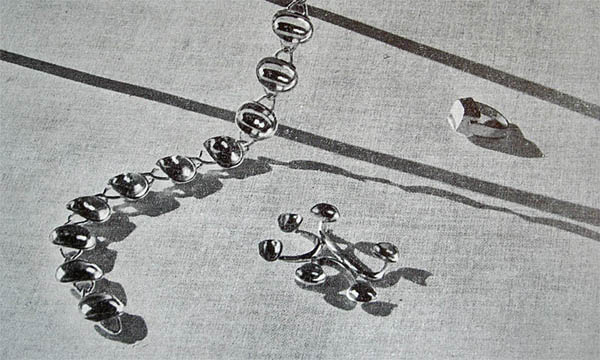 Sigurd Persson from
Stockholm was a contributor from Sweden. Persson was especially famous for his modern
serial production designs. He initially was the chief designer of the most progressive
jewelry company in Sweden, Atelier Stigbert, but in 1952 started his own studio.
He is another Martinshof contributor who won the prestigious European Goldsmith of the
Year award.
Sigurd Persson from
Stockholm was a contributor from Sweden. Persson was especially famous for his modern
serial production designs. He initially was the chief designer of the most progressive
jewelry company in Sweden, Atelier Stigbert, but in 1952 started his own studio.
He is another Martinshof contributor who won the prestigious European Goldsmith of the
Year award.
Martinshof was the promoter and distributor of his 'Scäla och Ruta' collection in Holland. This was designed using
two simple shapes only, concave elliptical dishes and rectangular diamond shapes, all
produced in silver. Unfortunately the general Dutch taste was not yet ready to
embrace the progressive modern Scandinavian style, and sales of this very affordable
product were rather poor.
Book : "Schmuck, von der Prinzessin Edda Marie zu Erbach-Schönberg"
Published in 1955 by Kultur-Verlag Kunst und Leben, Emden, Germany
Next -
Previous -
Top -
Page 1 -
Photos -
Michael's Blog -
Jazclass Links
20. Atelier Martinshof : Summer Exposition of 1952
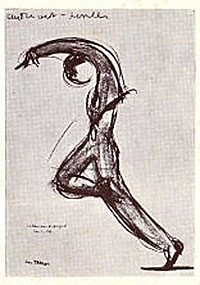 The undisputed highlight and, certainly for me, most memorable event of the Atelier Martinshof years, was the exposition in the summer of 1952 held at our own home in Eefde.
The undisputed highlight and, certainly for me, most memorable event of the Atelier Martinshof years, was the exposition in the summer of 1952 held at our own home in Eefde.
The entire ground floor of Martinshof was used for exposition space : lounge, dining room, office and studio, plus the large lawn outside. Only the kitchen and library were kept for our personal use.
The exposition was held over two full summer months with a wide selection of art on display. There was of course the jewelry of our regular contributors : Maud Smit, Eweg, Archibald Dumbar, Chris Steenbergen, Edda Marie Dierkes, Sigurd Persson, and hand made dolls by my mother.
We had also a selection of charcoal and gouache drawings from the French painter Jean Target, depicting dancers, with his highly characteristic strong flowing sinuous lines. I absolutely loved these.
Another contributing artist, also from Paris, was a lady (forgot her name, "Madam.....") who arrived at Martinshof on the back of a 750cc BMW motorbike driven by her friend the well known Japanese sculptor Shinkichi Tajiri.
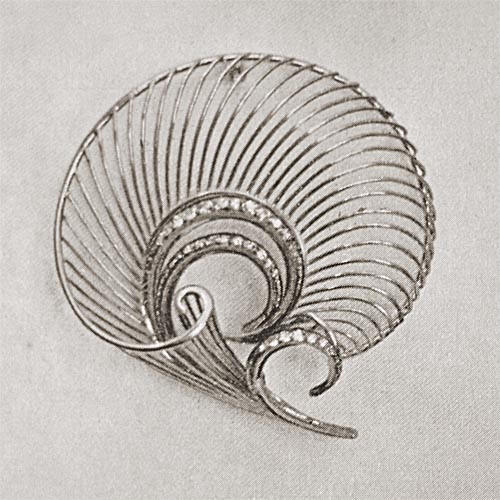
I vividly remember us sitting around the table in the Martinshof lounge while she unwrapped her creations : the most amazing jewelry made of short lengths of 2-3mm (0.1inch) thick steel wire roughly soldered together into large bold shapes containing irregular fragments of antique glass (up to 3cm, 1+inch in size) in various colours.
I particularly remember a pair of ear hangers, stretching (like a cloth hanger) 10-12 cm out horizontally underneath the ear with on each end a cube shaped steel wire basket containing a loose piece of coloured glass. It was extraordinary, and could easily be used as a decoration hanging against a wall.
Curiously I was reminded of her work just the other day (29 May, 2009) when photographing the coloured glass fragments in the pavement around the Darwin Airport Gateway Motel's swimming pool. The fragments in the lady's jewelry where shaped just like that, except of course considerably larger in size.
Next -
Previous -
Top -
Page 1 -
Photos -
Michael's Blog -
Jazclass Links
21. Atelier Martinshof : Piet Slegers at our Summer Exposition of 1952
 Complementing the small scale art inside, there were 6 large sculptures by the then young
Dutch sculptor Piet Slegers on display on our lawn.
Complementing the small scale art inside, there were 6 large sculptures by the then young
Dutch sculptor Piet Slegers on display on our lawn.
Slegers had just returned
from an apprenticeship with the famous sculptor Henri Moore in England, and this
recent association showed of course strongly in his work at that time.
The sculptures
were crafted in either white or charcoal black cement smoothed over a steel mesh and wire
frame. They were simplified smooth rounded abstract human forms each expressing a distinct
mood or intention.
Piet Slegers on principle never gave his creation a title or name, this way, he felt, the
observer would be free to make his/her own interpretation of his work. We however
had provisional names for the sculptures, reflecting, what we perceived to be, their
essence. I still remember them all, they were :
In white : "Striving for higher things" and "Mother and Child"
In black : "The Thinker" and "The
Harvester", and (not on the photo) "The Madonna" and
the "Struggler for Freedom"
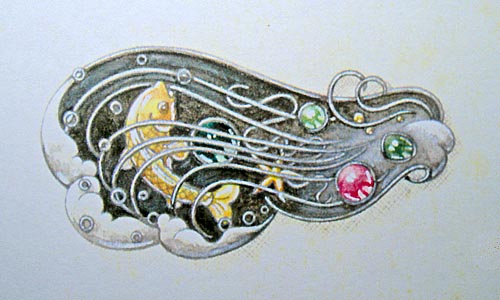 Throughout that summer we received regular busloads of ladies at Martinshof. As my father
usually was away on the road, my mother and I would divide each group into two, guiding
each one group around the exhibition. One of us would start in the studio pointing out and
explaining all the goldsmith's traditional tools (including of course the traditional
rabbit foot used for collecting all gold dust) while the other started in the garden.
Throughout that summer we received regular busloads of ladies at Martinshof. As my father
usually was away on the road, my mother and I would divide each group into two, guiding
each one group around the exhibition. One of us would start in the studio pointing out and
explaining all the goldsmith's traditional tools (including of course the traditional
rabbit foot used for collecting all gold dust) while the other started in the garden.
I
most enjoyed showing the ladies around the sculptures of Piet Slegers. First, while
standing on the terrace overlooking the entire group, there would always be much giggling
and funny remarks about these "unperfect" human images. But as I slowly took them onto the
grass, explaining close up each sculpture in turn, their attitude always dramatically
changed. In the end they would leave the garden with a much greater appreciation of modern
art, which in turn left me with a most rewarding feeling.
So when Slegers dropped in one afternoon to see how things were going, I (age 15)
enthusiastically took him around the lawn explaining to him my interpretations of each of
his own creations. He took it very good naturedly and with a smile on his face. We must
have been quite a pair to watch, both wearing black French barrettes, he twice as tall (and
old) and skinny me excitedly gesticulating at each of his sculptures.
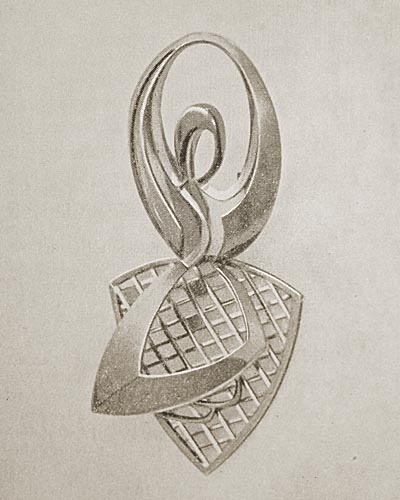 Although very simple in shape these early sculptures of Slegers had an enormous strength in
both line and form, and are etched in my mind forever. Probably due to a lack of funds to
remove them these six sculptures remained on our lawn for a couple of years, which we all
appreciated enormously.
Although very simple in shape these early sculptures of Slegers had an enormous strength in
both line and form, and are etched in my mind forever. Probably due to a lack of funds to
remove them these six sculptures remained on our lawn for a couple of years, which we all
appreciated enormously.
Eventually Piet took them back to his studio and destroyed them
all. He had dramatically changed his style, leaving the smooth rounded forms behind him
and producing initially very spiky sculptures instead, which reminded me at the time of the work of
Japanese sculptor Tajiri. In the end Slegers progressed to bold sharp geometric
forms, some embedded in nature itself, one of which can be seen at the Kröller Müller Museum
(near Otterloo NW of Arnhem) in the
Netherlands.
Piet Slegers went on to become one of the icons of Dutch modern art, counting the
present Dutch Queen Beatrix amongst his regular students. My brother Claus too worked with Slegers in
the early years, now producing interesting work in various mediums, including sculpture.
Comments -
Next -
Previous -
Top -
Page 1 -
Photos -
Michael's Blog -
Jazclass Links
Copyright © 2009 Michael Furstner
|



